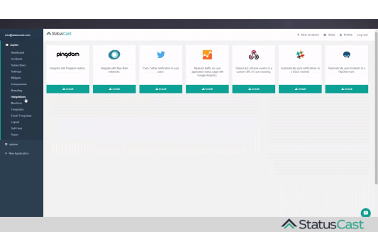This is the third video in our blog series, Setting Up Different Status Page Integrations.
To provide some context, last month, our product manager, Eric Warth put together a few quick (3-5 min) videos to help new users with some of the basics of setting up your software status page. I’ll be sharing them one at a time on this blog, but you can view them as we post them up on YouTube here.
- Integrating with Application Performance Monitoring (APM) tools, such as New Relic
- Where to find the KnowledgeBase articles for integrations
- Building alerts
- Integrating with end-user communication and tracking tools, such as Twitter and Google Analytics
Why a Status Page Needs APM Integrations
The point of a status page is to inform end-users when there’s a performance issue with software or devices they rely upon to do their respective jobs.
When end-users encounter an issue (whether they’re customers and it’s a SaaS product of yours, or whether they’re coworkers and it’s office-wide software your IT team is responsible for), requests for information are going to come to your IT/DevOps team. The team will either answer these requests—and be distracted from resolving the actual issue—or they’ll focus on solving the problem, and ignore the escalating volume and intensity of inquiries coming at them. Obviously, neither of these is a desirable scenario.
A status page integrated with your APM tool(s) eliminates the need for your IT team to respond to disruptive requests while still providing end-users with timely, transparent communication about the uptime status of the tools they’re currently experiencing issues with.
When integrated with StatusCast, your APM will actually automatically trigger a notification to end-users when it detects an issue with the software or devices it’s been designed to monitor. As Eric discusses in the video, you can set these alerts to send immediately, after a delay, or not at all until they receive manual approval—so while these alerts can be automatic, they don’t need to be.
Why Uptime Status is Best Conveyed via Status Page Integration
As mentioned above, transparent, timely communication of uptime status to your end users is important to mitigate the level of frustration they likely feel when they can’t do their jobs because of application performance issues.
It’s important to note, communicating uptime status can be proactive as well – if you have scheduled maintenance for instance, your end-users would likely appreciate being notified ahead of time (and likely would also appreciate being notified several times, perhaps the week before, the day before and a few times the day of). This can be achieved with a status page as well.
Best practice is to offer your end-users multiple means of subscribing to updates – this makes end-users less likely to complain about not having seen updates and also less likely to view your uptime status updates as spam.
Twitter, text/SMS, and email are popular but by no means are the only methods of communication. Messaging apps like Slack or HipChat can be integrated as well, if your end-users would prefer to receive uptime status alerts via those channels.
By setting up these notifications ahead of time, your DevOps or Marketing team (or whomever you task with creating the end-user-facing alerts), can be free to direct their attention to more demanding tasks, rather than to generic communication that could easily have been automated.






